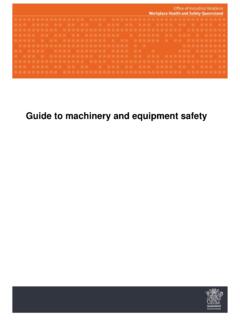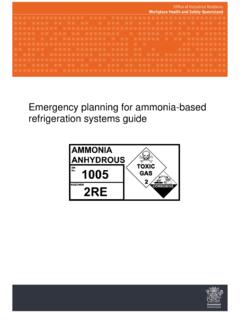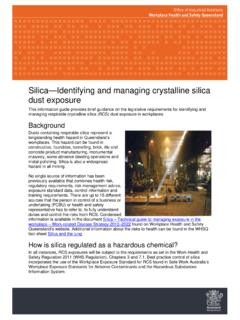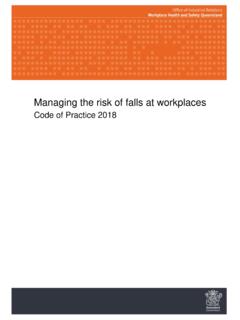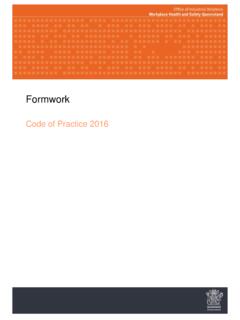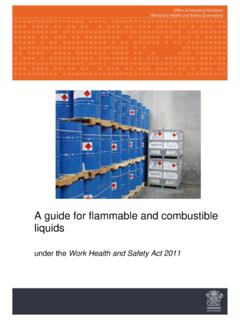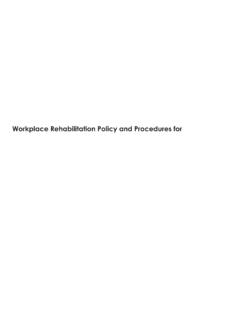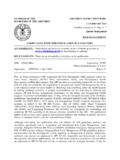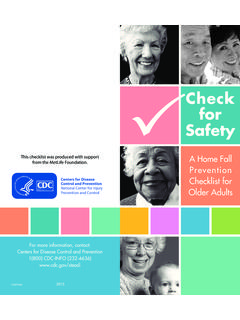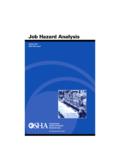Transcription of How to Manage Work Health and Safety Risks Code of ...
1 How to Manage work Health and Safety Risks Code of Practice 2011 How to Manage work Health and Safety Risks Code of practice 2011 (PN11157) page 2 of 27 This code is based on a national model code of practice developed by Safe work Australia and approved by the Workplace Relations Ministers Council on 10 August 2011 as part of the harmonisation of work Health and Safety laws. This Queensland code of practice was made by the Minister for Education and Industrial Relations on 27 November 2011 and published in the Queensland Government Gazette on 2 December 2011. This code commenced on 1 January 2012. This code was varied on 1 July 2018 by the Minister for Education and Minister for Industrial Relations. PN11157 Creative Commons This copyright work is licensed under a Creative Commons Attribution-Noncommercial Australia licence. To view a copy of this licence, visit In essence, you are free to copy, communicate and adapt the work for non-commercial purposes, as long as you attribute the work to Safe work Australia and abide by the other licence terms.
2 How to Manage work Health and Safety Risks Code of practice 2011 (PN11157) page 3 of 27 Contents Foreword .. 4 Scope and application .. 4 1. Introduction .. 6 Who has responsibility for managing work Health and Safety Risks ? .. 6 The meaning of key terms .. 6 What is involved in managing Risks ? .. 6 When should a risk management approach be used? .. 8 2. Step 1 How to identify hazards .. 10 How to find hazards .. 10 3. Step 2 How to assess Risks .. 12 When should a risk assessment be carried out? .. 12 How to do a risk assessment .. 12 4. Step 3 How to control Risks .. 15 The hierarchy of risk control .. 15 How to develop and implement control options .. 17 How to ensure that controls remain effective .. 18 5. Step 4 How to review controls .. 19 6. Keeping records .. 20 Appendix A Assessing how things go wrong .. 21 Appendix B Risk 22 Appendix C Case studies .. 23 Case Study 1: .. 23 Case Study 2: .. 25 How to Manage work Health and Safety Risks Code of practice 2011 (PN11157) page 4 of 27 Foreword The How to Manage work Health and Safety Risks Code of Practice is an approved code of practice under section 274 of the work Health and Safety Act 2011 (the WHS Act).
3 An approved code of practice is a practical guide to achieving the standards of Health , Safety and welfare required under the WHS Act and the work Health and Safety Regulation 2013 (the WHS Regulation). From 1 July 2018, duty holders are required to comply either with an approved code of practice under the WHS Act or follow another method, such as a technical or an industry standard, if it provides an equivalent or higher standard of work Health and Safety to the standard required in the code. A code of practice applies to anyone who has a duty of care in the circumstances described in the code. In most cases, following an approved code of practice would achieve compliance with the Health and Safety duties in the WHS Act, in relation to the subject matter of the code. Like regulations, codes of practice deal with particular issues and do not cover all hazards or Risks that may arise. The Health and Safety duties require duty holders to consider all Risks associated with work , not only those for which regulations and codes of practice exist.
4 Codes of practice are admissible in court proceedings under the WHS Act and WHS Regulation. Courts may regard a code of practice as evidence of what is known about a hazard, risk or control and may rely on the code in determining what is reasonably practicable in the circumstances to which the code relates. Compliance with the WHS Act and WHS Regulation may be achieved by following another method, such as a technical or an industry standard, if it provides an equivalent or higher standard of work Health and Safety than the code. An inspector may refer to an approved code of practice when issuing an improvement or prohibition notice. This may include issuing an improvement notice for failure to comply with a code of practice where equivalent or higher standards of work Health and Safety have not been demonstrated. This code of practice has been developed by Safe work Australia as a model code of practice under the Council of Australian Governments Inter-Governmental Agreement for Regulatory and Operational Reform in Occupational Health and Safety for adoption by the Commonwealth, state and territory governments.
5 Scope and application This code provides practical guidance for persons who have duties under the WHS Act and WHS Regulation to Manage Risks to Health and Safety . The duty is placed on persons conducting a business or undertaking, including employers, self-employed people, principal contractors, persons with management or control of a workplace, designers, manufacturers, importers and suppliers of plant, substances or structures that are used for work . This code applies to all types of work and all workplaces covered by the WHS Act. Other approved codes of practice should be referenced for guidance on managing the risk of specific hazards. How to use this code of practice In providing guidance, the word should is used in this code to indicate a recommended course of action, while may is used to indicate an optional course of action. How to Manage work Health and Safety Risks Code of practice 2011 (PN11157) page 5 of 27 This code also includes various references to sections of the WHS Act and to WHS Regulation which set out the legal requirements.
6 These references are not exhaustive. The words must , requires or mandatory indicate that a legal requirement exists and must be complied with. How to Manage work Health and Safety Risks Code of practice 2011 (PN11157) page 6 of 27 1. Introduction Who has responsibility for managing work Health and Safety Risks ? The WHS Act and WHS Regulation require persons who have a duty to ensure Health and Safety to Manage Risks by eliminating Health and Safety Risks so far as is reasonably practicable, and if it is not reasonably practicable to do so, to minimise those Risks so far as is reasonably practicable. Persons conducting a business or undertaking (PCBU) will have Health and Safety duties to Manage Risks if they: engage workers to undertake work for them, or if they direct or influence work carried out by workers may put other people at risk from the conduct of their business or undertaking Manage or control the workplace or fixtures, fittings or plant at the workplace design, manufacture, import or supply plant, substances or structures for use at a workplace install, construct or commission plant or structures at a workplace.
7 Deciding what is reasonably practicable to protect people from harm requires taking into account and weighing up all relevant matters, including: the likelihood of the hazard or risk concerned occurring the degree of harm that might result from the hazard or risk knowledge about the hazard or risk and ways of eliminating or minimising the risk the availability and suitability of ways to eliminate or minimise the risk after assessing the extent of the risk and the available ways of eliminating or minimising the risk, the cost associated with available ways of eliminating or minimising the risk, including whether the cost is grossly disproportionate to the risk. The process of managing risk described in this code will help you decide what is reasonably practicable in particular situations so that you can meet your duty of care under the WHS laws. Officers (for example company directors) must exercise due diligence to ensure that the business or undertaking complies with the WHS Act and WHS Regulation.
8 This includes taking reasonable steps to: gain an understanding of the hazards and Risks associated with the operations of the business or undertaking ensure that the business or undertaking has and uses appropriate resources and processes to eliminate or minimise Risks to Health and Safety . A person can have more than one duty and more than one person can have the same duty at the same time. The meaning of key terms Hazard means a situation or thing that has the potential to harm a person. Hazards at work may include: noisy machinery, a moving forklift, chemicals, electricity, working at heights, a repetitive job, bullying and violence at the workplace. Risk is the possibility that harm (death, injury or illness) might occur when exposed to a hazard. Risk control means taking action to eliminate Health and Safety Risks so far as is reasonably practicable, and if that is not possible, minimising the Risks so far as is reasonably practicable. Eliminating a hazard will also eliminate any Risks associated with that hazard.
9 How to Manage work Health and Safety Risks Code of practice 2011 (PN11157) page 7 of 27 What is involved in managing Risks ? Management commitment Effective risk management starts with a commitment to Health and Safety from those who operate and Manage the business or undertaking. You also need the involvement and cooperation of your workers, and if you show your workers that you are serious about Health and Safety they are more likely to follow your lead. To demonstrate your commitment, you should: get involved in Health and Safety issues invest time and money in Health and Safety ensure Health and Safety responsibilities are clearly understood. A step-by-step process A safe and healthy workplace does not happen by chance or guesswork. You have to think about what could go wrong at your workplace and what the consequences could be. Then you must do whatever you can (in other words, whatever is reasonably practicable ) to eliminate or minimise Health and Safety Risks arising from your business or undertaking.
10 This process is known as risk management and involves the four steps set out in this code (see Figure 1 below): Identify hazards find out what could cause harm. Assess Risks if necessary understand the nature of the harm that could be caused by the hazard, how serious the harm could be and the likelihood of it happening. Control Risks implement the most effective control measure that is reasonably practicable in the circumstances. Review control measures to ensure they are working as planned. Figure 1: The risk management process Many hazards and their associated Risks are well known and have well established and accepted control measures. In these situations, the second step to formally assess the risk is unnecessary. If, after identifying a hazard, you already know the risk and how to control it effectively, you may simply implement the controls. How to Manage work Health and Safety Risks Code of practice 2011 (PN11157) page 8 of 27 Risk management is a proactive process that helps you respond to change and facilitate continuous improvement in your business.
